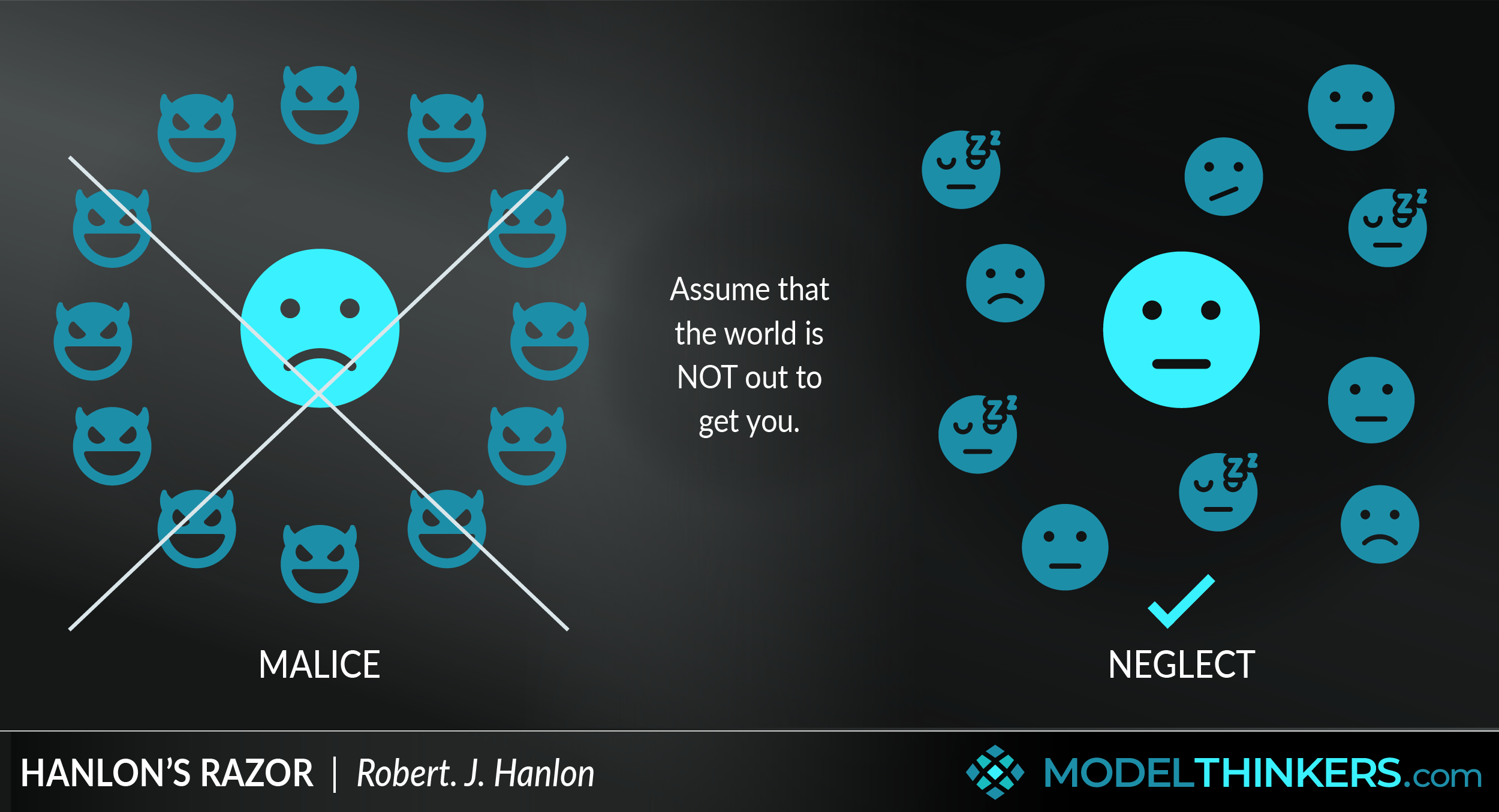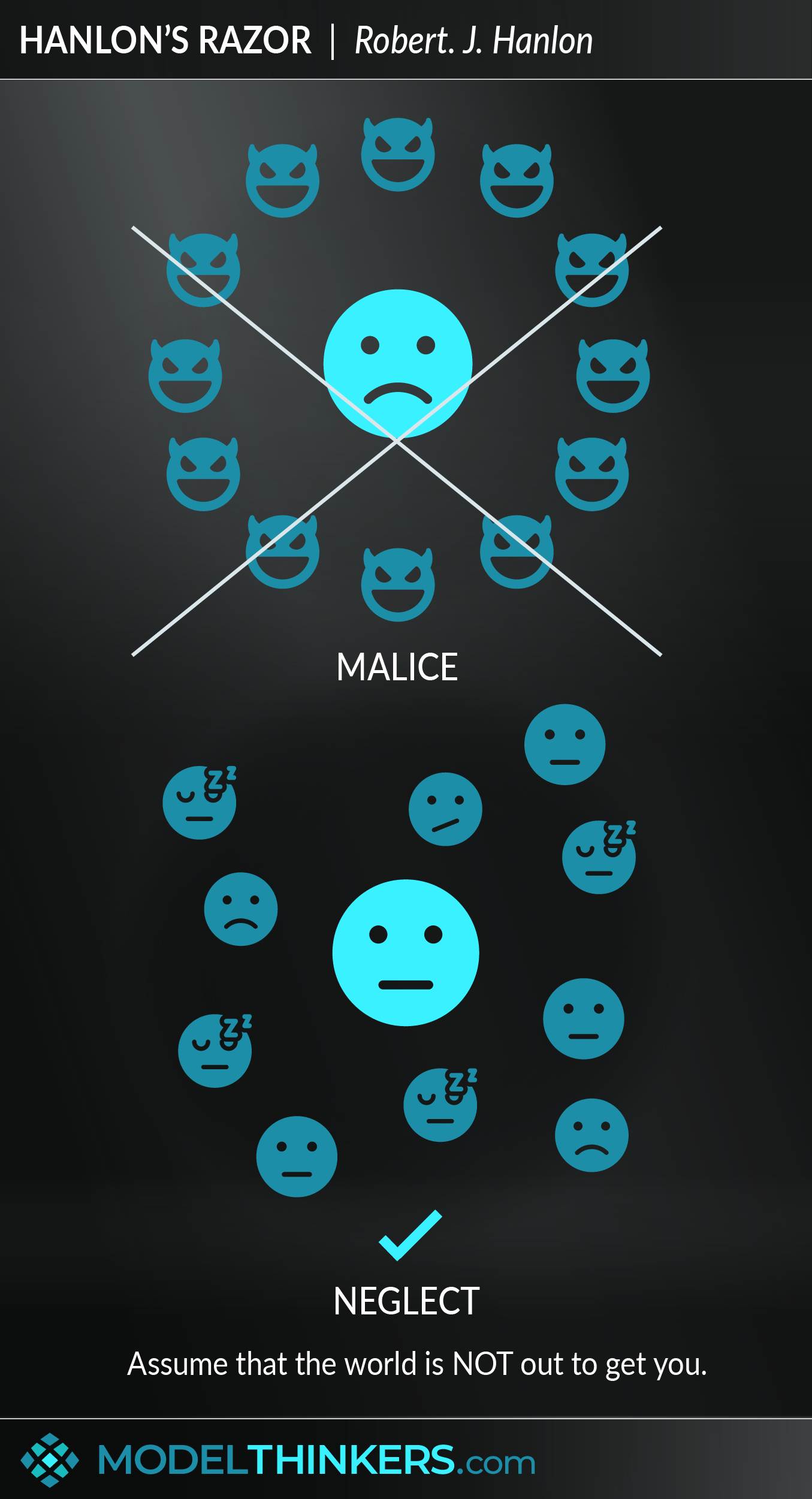

 0 saved
0 saved
 107.3K views
107.3K views








Stop being so paranoid. Not everyone is out to get you, they're just busy.
Hanlon’s Razor is a reminder that not everyone is plotting against you so it’s worth giving people who annoy you the benefit of the doubt.
NOT MALICE, HUMANS.
Hanlon’s Razor states: never attribute to malice that which can be adequately explained by neglect, ignorance or incompetence. Many quotes of this model focus on ‘stupidity’, which it could be argued gives it an arrogant twist — I find the broader interpretation more useful.
When we are slighted or ignored, it’s all too easy to assume malicious intent, all the while forgetting how many times we have treated others in a similar way. In reality, people are as neglectful, distracted, tired, misunderstanding, and incompetent as us. It is rarely the case that they are malicious.
FROM OCCAM'S RAZOR.
Hanlon’s Razor can be considered to be Occam's razor applied to social relationships, use it to develop an objective and rational approach that can interrupt anger at a perceived affront. In doing so, it can help you to be less judgmental and reactive as you maintain openness and curiosity to develop better relationships.




- Stop thinking it’s all about you
It’s common to think that you are the central role in everyone else’s story but the truth is that people’s behaviour will often have little to do with us. Hanlon’s razor is a reminder to maintain perspective and understand that others have as complex and demanding lives as our own.
- Put aside paranoia, assume good intentions of busy people
Remember that people generally are not out to get you and consider alternatives to explain behaviour before jumping to conclusions. Especially that they might be tired, distracted, busy, or just have a different understanding of what was expected.
- Use Hanlon’s Razor to cut through sensationalist media coverage and conspiracy theories
Media outlets leverage outrage and sensationalism to attract audiences and often attribute malice to what could be explained by incompetence or ignorance. Use Hanlon’s razor to filter and gain a better perspective on information from media sources.
Applied indiscriminately, Hanlon’s Razor can prevent people from identifying true malice. Hanlon’s razor supports a positive first reaction but the events that trigger it might still warrant further investigation to verify.
Office politics.
A classic application of this mental model plays out daily in office environments. When a team member does not deliver, or says something that frustrating it is easy to see a pattern of behaviour. Using Hanlon’s razor can help to interrupt that view and engage with greater positivity.
That said, there will be rare times when Hanlon’s razor does not apply and they are actually out to get you!
Hanlon’s razor helps to interrupt bias and supports a positive frame when we are annoyed by the behaviour of others.
Use the following examples of connected and complementary models to weave Hanlon’s razor into your broader latticework of mental models. Alternatively, discover your own connections by exploring the category list above.
Connected models:
- Fast thinking, slow thinking: related to our initial response to being annoyed that Hanlon’s razor can interrupt.
- Occam’s razor: a more comprehensive way of looking for the simplest explanation, in some ways Hanlon’s razor is a subset of this broader mental model.
- Availability bias: which might tinge our view of others behaviours.
- Non-violent communication: to consider facts rather than just emotional responses.
- Confirmation bias: interrupt our tendency to seek out supporting evidence.
Complementary models:
- Cialdini’s six principles of influence: to further development of positive relationships.
- Overton window: to help support healthy political debate, analysis and change.
- The scientific method: to help discover whether malice was actually at play.
Hanlon’s Razor was apparently named after Robert J. Hanlon and appeared in the Jargon File, a glossary of computer programmer slang.
However, the aphorism had been observed before in Robert A. Heinlein's novella Logic of Empire (1941) and some sources even cite Napoleon Bonaparte declaring ‘Never ascribe to malice that which is adequately explained by incompetence.
 My Notes
My Notes
Oops, That’s Members’ Only!
Fortunately, it only costs US$5/month to Join ModelThinkers and access everything so that you can rapidly discover, learn, and apply the world’s most powerful ideas.
ModelThinkers membership at a glance:






“Yeah, we hate pop ups too. But we wanted to let you know that, with ModelThinkers, we’re making it easier for you to adapt, innovate and create value. We hope you’ll join us and the growing community of ModelThinkers today.”



















































































